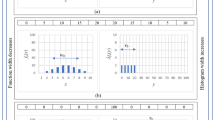Abstract
According to the Rayleigh criterion of classical optics, the finite resolving power of a microscope is due to the width of the central peak of the Fraunhofer diffraction pattern produced by the microscope's finite lens aperture. During the last few decades, theories and techniques for superresolution beyond the Rayleigh criterion have been developed in classical optics. Thus, Heisenberg's microscope could also in principle be made to give superresolution and thereby appear to violate the uncertainty relation. We believe that this paradox is due to the inappropriate use of a definition, based purely on experimental convenience, to support a quantum mechanical theorem.
Similar content being viewed by others
References
E. Schrödinger,Berliner Berichte 1930, 296–303.
E. Merzbacher,Quantum Mechanics, 2nd ed. John Wiley, New York, 1970), pp. 157–161.
M. Bunge, Interpretation of Heisenberg's Inequalities, inDenken und Umdenken, H. Pfeiffer, ed. (R. Piper & Co., Verlag, Munchen, 1977), pp. 146–156.
W. Heisenberg,Z. Phys. 43, 172–198 (1927).
W. Heisenberg,The Physical Principles of Quantum Theory (Dover, New York, 1949), Chapter 2.
M. Jammer,The Philosophy of Quantum Mechanics (John Wiley, New York, 1974), Chapter 3.
D. J. Blokhinstev,Quantum Mechanics (D. Reidel, Dordrecht, Holland, 1964); D. Bohm,Quantum Theory (Prentice Hall, Englewood Cliffs New Jersey, 1951).
R. H. Dicke and J. P. Wittke,Introduction to Quantum Mechanics (Addison-Wesley, Menlo Park, California, 1960), Chapter 2.
J. W. Goodman,Introduction to Fourier Optics (McGraw-Hill, New York, 1968), pp. 133–136.
G. B. Parrent and B. J. Thompson,Physical Optics Note Book (Society of Photo-Optical Instrumentation Engineers, 1969).
G. Toraldo di Francia,J. Opt. Soc. Am. 45, 497–501 (1955).
N. J. Bershad,J. Opt. Soc. Am. 59, 157–163 (1969).
M. Born and E. Wolf,Principles of Optics, 5th ed., (Pergamon, New York, 1975), pp. 416–417.
L. E. Ballentine,Rev. Mod. Phys. 42, 358–381 (1970).
G. Beck and G. M. Nussenzveig,Nuv. Cimento Ser. 10 9, 1068–1976 (1958).
P. Langlois, M. Cornier, R. Beaulieu, and M. Blanchard,J. Opt. Soc. Am. 67, 87–92 1977).
C. Roychoudhuri, Causality and Classical Interference and Diffraction Phenomena,Bol. Inst. Tonantzintla 2, 165 (1977); for abstracts seeJ. Opt. Soc. Am. 65, 1224A (1975),66, 1073A (1976).
W. E. Lamb, Jr.,Physics Today 22(A), 23 (1969).
C. Roychoudhuri,Bol. Inst. Tonantzintla 1, 259–264 (1975); C. Roychoudhuri, R. Machorro, and M. Cervantes,Bol. Inst. Tonantzintla 2, 55–62 (1976).
B. d'Espagnat,Conceptual Development of Quantum Mechanics (Benjamin, Menlo Park, California, 1971), p. 13.
Author information
Authors and Affiliations
Rights and permissions
About this article
Cite this article
Roychoudhuri, C. Heisenberg's microscope—A misleading illustration. Found Phys 8, 845–849 (1978). https://doi.org/10.1007/BF00715058
Received:
Issue Date:
DOI: https://doi.org/10.1007/BF00715058




